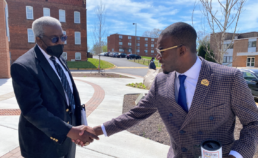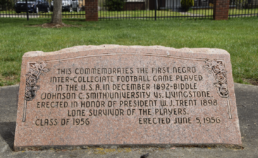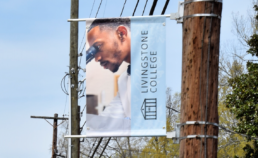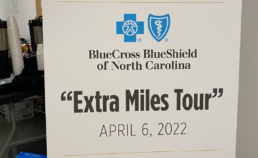Rowan County April 2022
Population
148,150
County Seat
Salisbury
Median Income
$51,054
Population Density Designation
Regional
Our visit to Rowan County centered around conversations held at Livingstone College, a private, historically Black Christian college in Salisbury. Education leaders, elected officials, and healthcare workers gathered to discuss how collaboration and alignment are critical to the vitality of the county.
Until the early 2000s, Rowan County had always been a textile community. “You had kids leaving school in the 9th and 10th grades to go to work for the textile mill,” said Greg Edds, chair of the Rowan County Commission. When those jobs started going away, the county suffered. In 2003, Rowan and the surrounding area lost more than 5,000 jobs in the largest single-day layoff in North Carolina’s history when the textile mill shut down.
With a population of roughly 143,000 residents, Rowan County has a poverty rate of 13.9% and unemployment rate of 6.20%─ both rates are above the state’s averages.
In 2019, education leaders and elected officials of Rowan County began to rethink how they could improve the lives of residents and businesses. It was a conversation that started with how they could increase the county’s educational attainment level. Despite the county having plenty of rich educational assets to offer, Craig Lamb, a vice president at Rowan-Cabarrus Community College, said leaders realized the level of attainment was poor.
As a result, the Rowan County Education Collaborative was born. The collaborative is a community initiative that works to increase educational attainment and build a talent pipeline so residents can flourish. The collaborative includes leaders from Rowan-Cabarrus Community College, Livingstone College, Catawba College, Rowan-Salisbury Schools, Rowan County Board of Commissioners, the Rowan County Manager, and the President of the Rowan Economic Development Commission. It meets at least once every month for one to two hours to address the key issues slowing educational attainment growth in their county.
Leaders from the collaborative understand the connection between the social determinants of health and an educated community. They are also keenly aware of the challenges that exist when it comes to removing roadblocks to education in their county. Those challenges include tuition and fees, lack of internship opportunities for students, inadequate funding for educational entities, housing insecurity, the opioid epidemic, and mental health needs. The county also lacks available building sites to attract would-be employers.
While these challenges cannot be eliminated in a single meeting, coming together to align efforts is an essential starting point for the Rowan County Education Collaborative.
Dr. Tunde Sotunde, President and CEO of Blue Cross NC, made a statement that, in many ways, highlights the work of the collaborative. He said, “Socio-economic development and the health of individuals in our communities go hand-in-hand. And I firmly believe it starts with education. It transcends not just our rural communities, but also our urban and suburban communities.”
Before concluding our visit in Rowan County, we heard from a panel of healthcare leaders. After receiving grant funding from Blue Cross NC in 2019, Rowan County Health Department, Rowan EMS, and the Center for Prevention Services implemented a post overdose response team. The team helps connect people to care and integrate them back into the community following an overdose.
In 2019, the county had 151 overdoses and six fatalities, but had a 62% rate of connecting with patients after their overdose. “We want to be on the frontlines, connecting with individuals within those first 24 to 72 hours,” said Alyssa Harris, public health director of Rowan County. The implementation of the post-overdose response team was timely given how the pandemic has exacerbated opioid usage. In 2021, the county had 755 overdoses and 59 fatalities.
The panel also discussed how the county is addressing childhood obesity. The county has partnered with a pediatric practice to identify children who are in the 95th percentile for height and weight and need intervention. Part of the program includes a referral to the Parks and Recreation Department and the YMCA for programming two nights a week for 90 minutes. Out of 90 minutes, 60 minutes are spent being physically active and the remaining 30 minutes are spent going over nutrition education.
“What is remarkable about this [program] is… we took those folks out of the healthcare setting, put them in the community setting and showed them where the resources are and how to interact with those resources,” Harris said.

Meet Dr. Algie Gatewood
Dr. Algie Gatewood is only the fourth President to lead Alamance Community College (ACC) since it opened in 1958. During Dr. Gatewood’s tenure at ACC, the college won its largest ever bond referendum – nearly $40 million – in 2018 to fund a number of major capital projects and expansions. The college also secured $16 million in county funding in 2014 to build the Advanced Applied Technology Center. Other notable accomplishments include creating a Biotechnology Center of Excellence, introducing an Early College, facilitating an apprenticeship program, and introducing nearly two dozen new academic programs and articulation agreements with state universities.
U39702, 12/22






